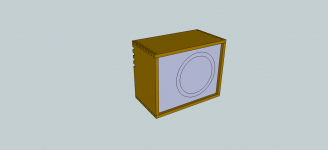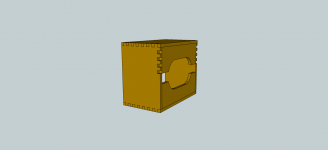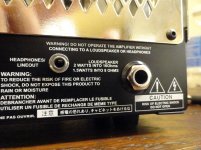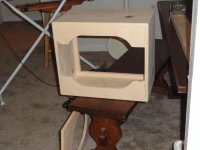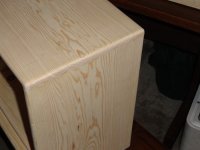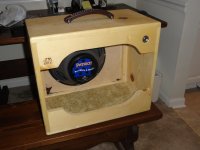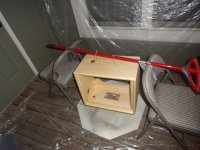On a regular trip to the Guitar Center a couple weeks ago I stumbled upon a Vox Lil' Night Train tube amp head, used, cheaper than I've seen them before. It was purchased.
Now that I have a head I'm gonna need a cab. I'd much rather build one than buy one.
I know the premises, and probably the whole project, is fairly simple. But, I have some questions and topics for input from those who have done it before.
My plan is 1 speaker in a box about 18"x18". I don't play very loud and don't want to have to carry a large cab around so I'm settling with 1 driver.
To build the box I'll use a 1x12 pine or oak or whatever they have at the Lowe's, finger joint the corners, and leave a pretty open back. I'll mount the speaker on a piece of 1/2" plywood and set it in the box. I'll either put some supports in the box or route out a grove for the speaker panel to fit into. Then probably build a frame, wrap it with some kind of mesh and put it on the front of the speaker panel.
I'm thinking either a 10" or 12" driver...ideally I can find something on craigslist that will work, however, a new one may be purchased. I know I don't want something that's going to require extensive break in.
My questions are:
1. What size speaker would an old pro recommend for this one. I'm assuming the difference between a 10" and a 12" is negligible. However, my head has an output to either a 16 ohm or an 8 ohm cab. This means I can use either a 8 or 16 ohm speaker, correct? Any advantage one to the other? Any suggestions on drivers for the job?
2. Wiring - I know I need a 1/4" input jack for the speaker cable. Is a speaker jack different than an instrument jack, I know the cables are different? Also, is there anything between the driver and the jack or is a cab really that simple - a speaker wired to a jack? and is there a + - that comes off of the jack and does it matter which connection on the speaker it goes to?
3. Anyone have any suggestions for a screen over the front of the speaker, material or mounting method? I can definitely devise something, but not sure if there is a tried and true method...
4. Finally speaker panel, that's what I'm calling the slab of wood the speaker is mounted on. How important is my material choice there? Do I need a 1/2" or 3/4" sturdy piece of plywood or can I use something 1/4" if I've got it lying around? Any thoughts on front or back mount?
I've attached some pictures. I modeled my thoughts in sketchup on the box...still kicking round ideas w/ the finger joints and speaker panel... there's also a picture of my head and output reading.
Thanks for the help
Now that I have a head I'm gonna need a cab. I'd much rather build one than buy one.
I know the premises, and probably the whole project, is fairly simple. But, I have some questions and topics for input from those who have done it before.
My plan is 1 speaker in a box about 18"x18". I don't play very loud and don't want to have to carry a large cab around so I'm settling with 1 driver.
To build the box I'll use a 1x12 pine or oak or whatever they have at the Lowe's, finger joint the corners, and leave a pretty open back. I'll mount the speaker on a piece of 1/2" plywood and set it in the box. I'll either put some supports in the box or route out a grove for the speaker panel to fit into. Then probably build a frame, wrap it with some kind of mesh and put it on the front of the speaker panel.
I'm thinking either a 10" or 12" driver...ideally I can find something on craigslist that will work, however, a new one may be purchased. I know I don't want something that's going to require extensive break in.
My questions are:
1. What size speaker would an old pro recommend for this one. I'm assuming the difference between a 10" and a 12" is negligible. However, my head has an output to either a 16 ohm or an 8 ohm cab. This means I can use either a 8 or 16 ohm speaker, correct? Any advantage one to the other? Any suggestions on drivers for the job?
2. Wiring - I know I need a 1/4" input jack for the speaker cable. Is a speaker jack different than an instrument jack, I know the cables are different? Also, is there anything between the driver and the jack or is a cab really that simple - a speaker wired to a jack? and is there a + - that comes off of the jack and does it matter which connection on the speaker it goes to?
3. Anyone have any suggestions for a screen over the front of the speaker, material or mounting method? I can definitely devise something, but not sure if there is a tried and true method...
4. Finally speaker panel, that's what I'm calling the slab of wood the speaker is mounted on. How important is my material choice there? Do I need a 1/2" or 3/4" sturdy piece of plywood or can I use something 1/4" if I've got it lying around? Any thoughts on front or back mount?
I've attached some pictures. I modeled my thoughts in sketchup on the box...still kicking round ideas w/ the finger joints and speaker panel... there's also a picture of my head and output reading.
Thanks for the help
Just some quasi random comments, feel free to ask for clarification:
Don't make the cabinet so square.
Use 3/4" plywood all around unless you want a very resonant cabinet. At least 3/4" for the baffle, this is where it matters most.
Use a 12" speaker - it'll sound more like a real guitar, less like a practice amp. No difference in ohmage, though some claim 16 ohms will use the whole transformer. Not sure that matters, or if it does, it's a good thing. But it's one of those ideas that has thought appeal.
The Vox cabinet uses a Celestion Greenback, my choice on a budget would be a Green Beret from WGS. They help smooth out the amp's crispy overdrive. (Great little amp, BTW.)
No difference in jacks, it's as simple as you think. Just don't use one of those long, threaded jacks - they sometimes lose contact. That's death to a tube amp. Absolute polarity, another idea with thought appeal. I've never heard it.
Don't make the cabinet so square.
Use 3/4" plywood all around unless you want a very resonant cabinet. At least 3/4" for the baffle, this is where it matters most.
Use a 12" speaker - it'll sound more like a real guitar, less like a practice amp. No difference in ohmage, though some claim 16 ohms will use the whole transformer. Not sure that matters, or if it does, it's a good thing. But it's one of those ideas that has thought appeal.
The Vox cabinet uses a Celestion Greenback, my choice on a budget would be a Green Beret from WGS. They help smooth out the amp's crispy overdrive. (Great little amp, BTW.)
No difference in jacks, it's as simple as you think. Just don't use one of those long, threaded jacks - they sometimes lose contact. That's death to a tube amp. Absolute polarity, another idea with thought appeal. I've never heard it.
I'm assuming the difference between a 10" and a 12" is negligible.
no, every driver will have its own 'signature'
This means I can use either a 8 or 16 ohm speaker, correct?
Any advantage one to the other?
you could choose to paralel 2x 10" 16ohm drivers(equals 8ohm)
guitar drivers are often available in 16ohm
Any suggestions on drivers for the job?
Fane AXA ?
I realized after writing most of this that you only asked a question or two - sorry if these opinions unrelated to your questions are an annoyance. However, since I typed them and you may find something valuable in there, I'll go ahead and post:
I agree to not go so square with the dimensions - that could encourage peaky response, though the open back should negate the issue. Also baffle size (the board the speaker is mounted to) will affect your bass response - bigger = more bass, so consider your application when determining size.
In my experience, the 12 will have more "warmth" and the 10 will be more "fizzy". I'm sure that there are drivers that go against this generalization.
I agree with the thought of using 3/4 material all around, baffle included. I suppose you may get a cool sound out of 1/2 baffle, and it may even "deepen" your tone as a larger surface will be vibrating than the speaker alone. but resonance could be a concern - I guess it depends some on whether you want to create a signature sound for the amp/speaker combo, or whether you want a "clean" sound that you can easily manipulate with effects. I've got a couple of boxes that are lively, boxey, "woody" sounding and are great for certain applications, but they aren't very flexible due to how they color the sound.
Put the supports in the box for the baffle. Many "float" their baffles by only supporting them on two sides - either vertically or horizontally. That could add resonance. If this is a consideration in your choice of 1/2 baffle board, you could always start that way and then add supports on the last two sides if the resonance is over-the-top. Obviously you could do 3/4 inch "floating" baffle as well. Speaker manufacturers recommend thicker baffles to prevent warping of speaker baskets, and this may be more of a concern with "floating" baffles.
For the baffle material, I'd choose plywood. If you are buying new, you may save yourself a headache by buying "cabinet grade" ply that has more layers. the cheaper stuff tends to have voids, which can translate into an annoying buzz. However, I've gotten away with sub-floor scraps from the garage without a buzz. If time is not a factor, and you have something thick enough lying around, you might try something similar. Avoid the 1/4 inch though. And test it installed before going through the trouble to put cloth on it in case it does buzz. Front mount is fine, or else you will have to work the mounting blocks/strips into the appearance of the amp.
If you are planning to stain the box, then the fingerjointed corners would be ideal and look nice. If you wrap it with tolex, some support blocks and keeping the nails or screws back from the corners (to be rounded over) could save you time and energy. Fingerjoints would be lighter, though, so if you are dead-set on shaving pounds i'd go that way and stain rather than tolex.
You might consider rear-loading the speakers to the baffle and wrapping the grill-cloth on the outside of the baffle before installing it (from the front) - like Fenders and many others. Staple the cloth on the edges of the baffle or wrap all the way to the back. If you do this, and if your cloth is particularly transparent, consider painting the baffle to match the speaker or the cloth unless you like to see the contrast of where the speaker actually is. dark for dark cloths, light for light, etc.
For a 15w amp, if you are just going for moderate volumes, watch for console stereos as they typically have efficient speakers in them which will get louder quicker. If you want to run the amp full volume then ditch that idea and go for a speaker rated at ~30w. I like old alnico console speakers but have damaged a couple from abuse - sounded great until they started buzzing though! They are generally sensitive but get compressed at higher volumes and sound awesome to me.
To my ears, an 8 ohm tap will tend to sound "fuller", and a 16 ohm will be a little more "hi-fi". I don't sit around testing things though - its just a possibly wrong generalization based on my experience, which isn't tremendous. I do match the impedance of the tap - so different speakers or wiring arrangements went into that observation, possibly making it moot. However, the concept that an amp "works" more to deliver higher wattage to an 8 ohm load vs 16 ohm load, may mean more output tube saturation and thereby "warmth".
The cables are different, the jacks are the same. Polarity (+/-) shouldn't be a concern unless you are running other speakers simultaneously, in which case you may encounter phase cancellation/peaky "hollow" overall response. Standard stereo speaker wire will work - 16 or 18 gauge is good for durability. Skip my fool mistake and thread the jack cover onto the wire before wiring the jack in!
I got sold on "cane" speaker grill material. I think my last batch came from Mojo musical supply. (no affiliation). I tried needle-point cloth first because it appeared sonically transparent enough, but when the bass tried to push through it cause vibration. I didn't find anything at the fabric store that was any better. Oh - a cheap electric stapler will make the job quicker.
Good luck! And try again on the pictures if you can!
I agree to not go so square with the dimensions - that could encourage peaky response, though the open back should negate the issue. Also baffle size (the board the speaker is mounted to) will affect your bass response - bigger = more bass, so consider your application when determining size.
In my experience, the 12 will have more "warmth" and the 10 will be more "fizzy". I'm sure that there are drivers that go against this generalization.
I agree with the thought of using 3/4 material all around, baffle included. I suppose you may get a cool sound out of 1/2 baffle, and it may even "deepen" your tone as a larger surface will be vibrating than the speaker alone. but resonance could be a concern - I guess it depends some on whether you want to create a signature sound for the amp/speaker combo, or whether you want a "clean" sound that you can easily manipulate with effects. I've got a couple of boxes that are lively, boxey, "woody" sounding and are great for certain applications, but they aren't very flexible due to how they color the sound.
Put the supports in the box for the baffle. Many "float" their baffles by only supporting them on two sides - either vertically or horizontally. That could add resonance. If this is a consideration in your choice of 1/2 baffle board, you could always start that way and then add supports on the last two sides if the resonance is over-the-top. Obviously you could do 3/4 inch "floating" baffle as well. Speaker manufacturers recommend thicker baffles to prevent warping of speaker baskets, and this may be more of a concern with "floating" baffles.
For the baffle material, I'd choose plywood. If you are buying new, you may save yourself a headache by buying "cabinet grade" ply that has more layers. the cheaper stuff tends to have voids, which can translate into an annoying buzz. However, I've gotten away with sub-floor scraps from the garage without a buzz. If time is not a factor, and you have something thick enough lying around, you might try something similar. Avoid the 1/4 inch though. And test it installed before going through the trouble to put cloth on it in case it does buzz. Front mount is fine, or else you will have to work the mounting blocks/strips into the appearance of the amp.
If you are planning to stain the box, then the fingerjointed corners would be ideal and look nice. If you wrap it with tolex, some support blocks and keeping the nails or screws back from the corners (to be rounded over) could save you time and energy. Fingerjoints would be lighter, though, so if you are dead-set on shaving pounds i'd go that way and stain rather than tolex.
You might consider rear-loading the speakers to the baffle and wrapping the grill-cloth on the outside of the baffle before installing it (from the front) - like Fenders and many others. Staple the cloth on the edges of the baffle or wrap all the way to the back. If you do this, and if your cloth is particularly transparent, consider painting the baffle to match the speaker or the cloth unless you like to see the contrast of where the speaker actually is. dark for dark cloths, light for light, etc.
For a 15w amp, if you are just going for moderate volumes, watch for console stereos as they typically have efficient speakers in them which will get louder quicker. If you want to run the amp full volume then ditch that idea and go for a speaker rated at ~30w. I like old alnico console speakers but have damaged a couple from abuse - sounded great until they started buzzing though! They are generally sensitive but get compressed at higher volumes and sound awesome to me.
To my ears, an 8 ohm tap will tend to sound "fuller", and a 16 ohm will be a little more "hi-fi". I don't sit around testing things though - its just a possibly wrong generalization based on my experience, which isn't tremendous. I do match the impedance of the tap - so different speakers or wiring arrangements went into that observation, possibly making it moot. However, the concept that an amp "works" more to deliver higher wattage to an 8 ohm load vs 16 ohm load, may mean more output tube saturation and thereby "warmth".
The cables are different, the jacks are the same. Polarity (+/-) shouldn't be a concern unless you are running other speakers simultaneously, in which case you may encounter phase cancellation/peaky "hollow" overall response. Standard stereo speaker wire will work - 16 or 18 gauge is good for durability. Skip my fool mistake and thread the jack cover onto the wire before wiring the jack in!
I got sold on "cane" speaker grill material. I think my last batch came from Mojo musical supply. (no affiliation). I tried needle-point cloth first because it appeared sonically transparent enough, but when the bass tried to push through it cause vibration. I didn't find anything at the fabric store that was any better. Oh - a cheap electric stapler will make the job quicker.
Good luck! And try again on the pictures if you can!
Last edited:
If you do not have prior speaker cabinet design experience, it might be better building a proven design such as the AX84 1x12 -> http://ax84.com/corecabinets/AX84_1x12_Cab_09.08.03.pdf. Also check out the design discussion (lots of good info there) -> http://ax84.com/corecabinets/1x12_Cab_Design_Thread.pdf.
I built mine using 18mm plywood with a 10" Ragin' Cajun and removable back (so it could be open back, semi-open or closed), and it sounds pretty good, if I had to do it again, I would go with solid pine instead of plywood for the sides.
Good luck with your project!
Jaz
I built mine using 18mm plywood with a 10" Ragin' Cajun and removable back (so it could be open back, semi-open or closed), and it sounds pretty good, if I had to do it again, I would go with solid pine instead of plywood for the sides.
Good luck with your project!
Jaz
The 8 ohm and 16 ohm settings allow you to connect multiple speakers or more than one cabinet without overloading the output. It just gives you more flexibility. If you will only be making one of these boxes and only run one then go the 8 ohm route. You will get a couple more dB out of it if you need to.
thanks for all the input
here's where im at
- abandoning the square box...going to something 16h x 20w x 11 1/4d
- i'm sticking with the 1x12s for the sides, and i'll go with 1/2 or 3/4 for the baffle, i'll see what i can get, maybe i can pick up a small sheet or a damaged sheet for cheap...if there's no scrap available
- i'm either going to brace all 4 sides of the baffle or route out for all 4 sides, to support it w/o a brace...i'll shim and glue it to prevent any rattling...probably going to stick with an open back, for simplicity if nothing else
-instead of covering the whole amp i'm going to dovetail the joints...either through or half blind dovetails...partially because i found this jig at harbor freight for way less than half it goes for anywhere else
-i'm thinking about mounting the speaker off center on the baffle, i guess this may create a 'signature' sound, a little bit of which i dont mind, as long as it doesnt shake the thing apart.
-my understanding is that my head is going to have a little crisper overdrive, which might be well complimented by a warmer creamy speaker...i'm doing my best not to order a brand new speaker...1 to save money, 2 to hopefully end up with something a little more broken in...is there somewhere i can get a fairly comprehensive description or comparison of different model drivers? ive been looking at different celestron, gsw, eminence and a couple other names i've seen come up
-does the grill material serve a function (other than to protect and look good)?..this may have a hand in my decision
I'm trying to post pictures again...the ones from last time, my updated sketchup with dimensions and considered dimensions...and my new dovetail jig
let me know if these don't work...the only way i've figured out to post them is as attachments
i'm going to be working on the cab this weekend, i'll have access to a shop then, probably just building the box...i'll continue my driver hunt until i hit gold
progress pictures will be posted...assuming i can figure out how to post em
here's where im at
- abandoning the square box...going to something 16h x 20w x 11 1/4d
- i'm sticking with the 1x12s for the sides, and i'll go with 1/2 or 3/4 for the baffle, i'll see what i can get, maybe i can pick up a small sheet or a damaged sheet for cheap...if there's no scrap available
- i'm either going to brace all 4 sides of the baffle or route out for all 4 sides, to support it w/o a brace...i'll shim and glue it to prevent any rattling...probably going to stick with an open back, for simplicity if nothing else
-instead of covering the whole amp i'm going to dovetail the joints...either through or half blind dovetails...partially because i found this jig at harbor freight for way less than half it goes for anywhere else
-i'm thinking about mounting the speaker off center on the baffle, i guess this may create a 'signature' sound, a little bit of which i dont mind, as long as it doesnt shake the thing apart.
-my understanding is that my head is going to have a little crisper overdrive, which might be well complimented by a warmer creamy speaker...i'm doing my best not to order a brand new speaker...1 to save money, 2 to hopefully end up with something a little more broken in...is there somewhere i can get a fairly comprehensive description or comparison of different model drivers? ive been looking at different celestron, gsw, eminence and a couple other names i've seen come up
-does the grill material serve a function (other than to protect and look good)?..this may have a hand in my decision
I'm trying to post pictures again...the ones from last time, my updated sketchup with dimensions and considered dimensions...and my new dovetail jig
let me know if these don't work...the only way i've figured out to post them is as attachments
i'm going to be working on the cab this weekend, i'll have access to a shop then, probably just building the box...i'll continue my driver hunt until i hit gold
progress pictures will be posted...assuming i can figure out how to post em
Attachments
Your plans look good!
Here's a popular comparison on YouTube:
15 Speakers compared Celestion vs E.V. vs Eminence vs JBL vs Jensen vs Tone Tubby - YouTube
The metal cage on your amp is mostly for looks and protection. It might provide a bit of shielding, but I doubt you'd notice a difference if you took it off.
Guitar speaker grill cloth is generally very heavy material so it doesn't get kicked in easily. It does take off some of the highs, but guitar speakers are voiced with this in mind.
Here's a popular comparison on YouTube:
15 Speakers compared Celestion vs E.V. vs Eminence vs JBL vs Jensen vs Tone Tubby - YouTube
The metal cage on your amp is mostly for looks and protection. It might provide a bit of shielding, but I doubt you'd notice a difference if you took it off.
Guitar speaker grill cloth is generally very heavy material so it doesn't get kicked in easily. It does take off some of the highs, but guitar speakers are voiced with this in mind.
Jaz, how do you use your cabinet? Open, semi-open, or closed?
Closed right now, it gives more punch, and projection (no surprise there).
Jaz
it might be better building a proven design such as the AX84 1x12
I'll second the AX84 cabinet. I built two of them and stuffed them with some $20 Ebay sourced Eminence 12 inch drivers. They were built according to the plans using 18 mm plywood from Home Depot.
One cabinet with the 18 watt amp I built in the $100 amp challenge sounds really nice and gets plenty loud. Both cabinets with a 100 Watt Marshall Super Lead is absolutely DEADLY. Ask my neighbors!
did work this weekend
put the cabinet together...half blind dovetails, open back, prepped the baffle for a 12" speaker...and sanded
just needs finishings now...for a finish i'm thinking a clear polyurethane, brown leather handle, and rubber feet (to keep it from rattling across the room)
my goal for the week is to get my driver, wiring, a jack...i'm gonna give the used gear hunt a day or two more then order something...so i'll be doing my homework this week
i'm posting some pictures, hopefully you cant see the wood filler....
put the cabinet together...half blind dovetails, open back, prepped the baffle for a 12" speaker...and sanded
just needs finishings now...for a finish i'm thinking a clear polyurethane, brown leather handle, and rubber feet (to keep it from rattling across the room)
my goal for the week is to get my driver, wiring, a jack...i'm gonna give the used gear hunt a day or two more then order something...so i'll be doing my homework this week
i'm posting some pictures, hopefully you cant see the wood filler....
Attachments
Finished this bad boy up.
I'm pleased with the sound and the style.
I sprayed on a clear polyurethane...used a fender style brown grill cloth...brown leather handle...i rigged up a fender ferrule and an enclosed 1/4" jack...i had a scrap of carpet lying around that i trimmed to size and fitted in the bottom of the cab
the used driver search failed be so i picked up a 12" eminence red white and blues...and mounted it to the back of the baffle
The only thing i'd change is i'd put the handle on the side of the cab, so i have more room to set the amp...rookie mistake
some pictures are below (including my patio/garage paint shop)
Thanks for all the help
I'm pleased with the sound and the style.
I sprayed on a clear polyurethane...used a fender style brown grill cloth...brown leather handle...i rigged up a fender ferrule and an enclosed 1/4" jack...i had a scrap of carpet lying around that i trimmed to size and fitted in the bottom of the cab
the used driver search failed be so i picked up a 12" eminence red white and blues...and mounted it to the back of the baffle
The only thing i'd change is i'd put the handle on the side of the cab, so i have more room to set the amp...rookie mistake
some pictures are below (including my patio/garage paint shop)
Thanks for all the help
Attachments
- Status
- Not open for further replies.
- Home
- Live Sound
- Instruments and Amps
- Speaker Cab Project and Questions
